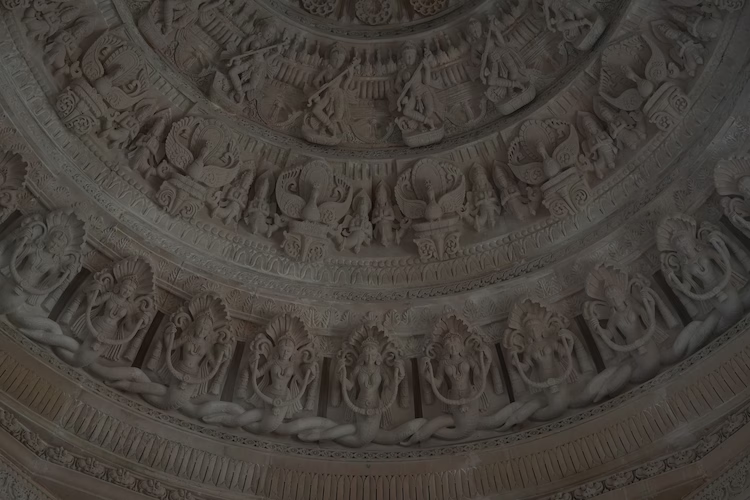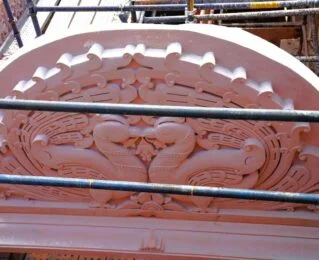A procession of tableaux displaying scenes from the life of Lord Rama with 100 idols of the deity will be taken out in Ayodhya on January 17, 2024 to mark the start of the week-long celebration for the Ram temple consecration ceremony.
(snaps -- offer inside view of the grand temple)
The temple complex, built in the traditional Nagara style, will be 380 feet long (east-west direction), 250 feet wide and 161 feet high.
Spanning 54,700 sq ft, the temple area covers nearly 2.7 acres of land. The entire Ram Mandir complex would be spread over nearly 70 acres and will be equipped to host about a million devotees at any time.
Prime Minister Narendra Modi will attend the 'Pran Pratishtha' event at Ayodhya's Ram temple on January 22. In fact, 'praan pratistha puja' is scheduled to begin on January 16 and will conclude on January 22.
Preparations for the ceremony are in full swing and are expected to conclude by January 15th. Most of the Ram temple compound will be a green area with hundreds of trees and the complex itself will be "Atmanirbhar".
Notably, a procession of tableaux displaying scenes from the life of Lord Rama with 100 idols of the deity will be taken out in Ayodhya on January 17 to mark the start of the week-long celebration for the Ram temple consecration ceremony.
The entry into the temple will be from the east side, and exit from the south side. The entire temple superstructure will eventually be three storeys. Visitors will climb 32 steps from the eastern side to reach the main temple.
The temple is a combination of exquisite craftsmanship and modern-day engineering.
Ending the years old title dispute on November 9, 2019, the Supreme Court accepted the 2.77 acres of disputed location as the birthplace of Lord Ram, paving the way for the construction of the Ram Mandir.
Prime minister Narendra Modi performed the Bhumi Poojan ceremony on August 5, 2020 and laid the foundation stone of the temple.
The superstructure of the Ram Mandir is built of carved Rajasthan Bansi Paharpur stone, the rare pink marble stones, world-renowned for its beauty and strength.
It will require a total of 4 lakh sq ft of stone.
The Bansi Paharpur Sandstone is found in the Bayana Tehsil of Bharatpur District in Rajasthan and it is available in hues of pink and red.
The centre, in 2021, gave an in-principal approval to convert 398 hectares of protected forest land into revenue land to allow the mining of the pink sandstone in the vicinity of the Band Baretha Wildlife Sanctuary in Bharatpur, reversing the ban on mining put in place in 2016.
The Bansi Pahadpur Sandstone has been used in various grand structures of the country, including the Akshardham Temple and the Parliament Complex.
Ayodhya Ram Mandir: Timeline
1528-1529: Mughal emperor Babur builds Babri Masjid
1850s: Start of communal violence over the land
1949: Ram Idol found inside the structure intensifying communal tension
1950: Two suits filed in Faizabad civil court seeking permission to worship the idol
1961: UP Sunni Central Wakf Board demands the removal of the idol
1986: District Court opens the site for Hindu worshippers
1989: Nearly 1.67 lakh bricks were brought to Ayodhya for Shilanyas.
1992: Babri masjid demolished on December 6
Sept 30. 2010: Allahabad HC rules three-way division of disputed area among Sunni Waqf Board, Nirmohi Akhara and Ram Lalla
2011: Supreme Court stays Allahabad HC order
2016: Subramanian Swamy files plea in SC, seeks the construction of Ram Temple
Nov 9, 2019: Supreme Court accepts Ayodhya was the birthplace of Lord Ram, hands over the entire 2.77 acres of disputed land to the trust and orders the government to give 5-acre land to Sunni Waqf Board as an alternate site
Aug 5, 2020: PM Narendra Modi performs Bhumi Poojan and lays the foundation stone
Jan 22, 2024 :: Now date scheduled for consecration
 |
( 1,67,063 Ram shilas (bricks) were collected from all over the world and transported to Ayodhya ) |














No comments:
Post a Comment